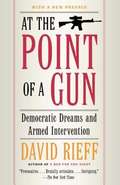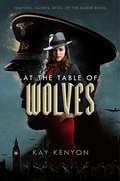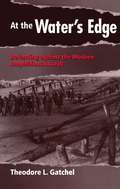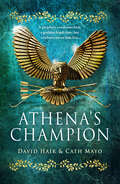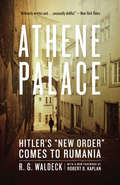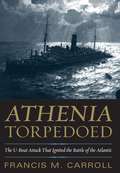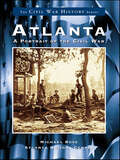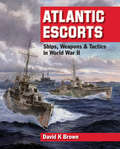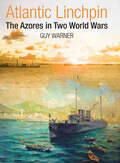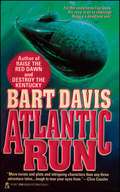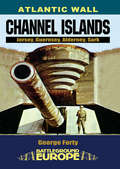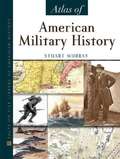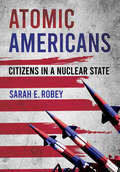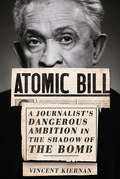- Table View
- List View
At the Mountain's Base (Cherokee edition)
by Traci SorellA family, separated by duty and distance, waits for a loved one to return home in this lyrical picture book celebrating the bonds of a Cherokee family and the bravery of history-making women pilots. Now available in Cherokee. At the mountain's base sits a cabin under an old hickory tree. And in that cabin lives a family -- loving, weaving, cooking, and singing. The strength in their song sustains them through trials on the ground and in the sky, as they wait for their loved one, a pilot, to return from war.With an author's note that pays homage to the true history of Native American U.S. service members like WWII pilot Ola Mildred "Millie" Rexroat, this is a story that reveals the roots that ground us, the dreams that help us soar, and the people and traditions that hold us up.
At the Point of a Gun: Democratic Dreams and Armed Intervention
by David RieffWriting from the front lines of the hot wars of the post-Cold War world -- the Balkans, Africa, the Middle East, and most recently Afghanistan and Iraq for The New York Times Magazine -- David Rieff witnessed firsthand most of the armed interventions waged by the West or the United Nations in the name of human rights and democratization. His report is anything but reassuring. In this timely collection of his most illuminating articles, Rieff, one of our leading experts on the subject, reassesses some of his own judgments about the use of military might to solve the world's most pressing humanitarian problems and curb the world's cruelest human rights abusers, presenting what, taken as a whole, is a thoughtful and impassioned argument against armed intervention in all but the most extreme cases. At the Point of a Gun raises critical questions we cannot ignore in this era of gunboat democracy. When, if ever, is it appropriate to intervene militarily in the domestic affairs of other nations? Are human rights and humanitarian concerns legitimate reasons for intervening, or is the assault on sovereignty -- sovereignty that is as much an article of faith at the UN as it is in Washington -- a flag of convenience for the recolonization of part of the world? What role should the United Nations play in alleviating humanitarian crises? And, above all, can democracy be imposed through the barrel of an M16?Collected here for the first time, Rieff's essays draw a searing portrait of what happens when the grandiose schemes of policymakers and the grandiose ethical ambitions of human rights activists go horribly wrong in the field. Again and again, they ask the question: Do these moral ambitions of ours to protect people from massacre and want match either our means or our wisdom? Rieff's articles appear as they were written. Some, however, are accompanied by brief reconsiderations in which the author describes how and why his thinking has changed both as he has reflected on what it means, as in Iraq, to impose democracy by force, and as he has witnessed, firsthand, what that redemptive project actually looks like in practice. This is not an optimistic report. To the contrary, it is the chastened conclusion of a writer who was once one of the leading advocates of such interventions. But the questions Rieff raises are of the essence as the United States grapples with the harsh consequences of what it has wrought on the ground in Afghanistan and Iraq.
At the Precipice: Americans North and South during the Secession Crisis
by Shearer Davis BowmanWhy did eleven slave states secede from the Union in 1860-61? Why did the eighteen free states loyal to the Union deny the legitimacy of secession, and take concrete steps after Fort Sumter to subdue what President Abraham Lincoln deemed treasonous rebellion? At the Precipice seeks to answer these and related questions by focusing on the different ways in which Americans, North and South, black and white, understood their interests, rights, and honor during the late antebellum years. Rather than give a narrative account of the crisis, Shearer Davis Bowman takes readers into the minds of the leading actors, examining the lives and thoughts of such key figures as Abraham Lincoln, James Buchanan, Jefferson Davis, John Tyler, and Martin Van Buren. Bowman also provides an especially vivid glimpse into what less famous men and women in both sections thought about themselves and the political, social, and cultural worlds in which they lived, and how their thoughts informed their actions in the secession period. Intriguingly, secessionists and Unionists alike glorified the Declaration of Independence and the Constitution of the United States, yet they interpreted those sacred documents in markedly different ways and held very different notions of what constituted "American" values.
At the Table of Wolves (A Dark Talents Novel)
by Kay KenyonTinker Tailor Soldier Spy meets X-Men in a classic British espionage story. A young woman must go undercover and use her superpowers to discover a secret Nazi plot and stop an invasion of England.In 1936, there are paranormal abilities that have slowly seeped into the world, brought to the surface by the suffering of the Great War. The research to weaponize these abilities in England has lagged behind Germany, but now it’s underway at an ultra-secret site called Monkton Hall. Kim Tavistock, a woman with the talent of the spill—drawing out truths that people most wish to hide—is among the test subjects at the facility. When she wins the confidence of caseworker Owen Cherwell, she is recruited to a mission to expose the head of Monkton Hall—who is believed to be a German spy. As she infiltrates the upper-crust circles of some of England’s fascist sympathizers, she encounters dangerous opponents, including the charismatic Nazi officer Erich von Ritter, and discovers a plan to invade England. No one believes an invasion of the island nation is possible, not Whitehall, not even England’s Secret Intelligence Service. Unfortunately, they are wrong, and only one woman, without connections or training, wielding her talent of the spill and her gift for espionage, can stop it.
At the Water's Edge
by Theodore GatchelThe amphibious assault against a defended beach is fully explored from the perspective of the defender.
At the Wolf's Table: A Novel
by Rosella PostorinoThe international bestseller based on a haunting true story that raises provocative questions about complicity, guilt, and survival.They called it the Wolfsschanze, the Wolf’s Lair. “Wolf” was his nickname. As hapless as Little Red Riding Hood, I had ended up in his belly. A legion of hunters was out looking for him, and to get him in their grips they would gladly slay me as well.Germany, 1943: Twenty-six-year-old Rosa Sauer’s parents are gone, and her husband Gregor is far away, fighting on the front lines of World War II. Impoverished and alone, she makes the fateful decision to leave war-torn Berlin to live with her in-laws in the countryside, thinking she’ll find refuge there. But one morning, the SS come to tell her she has been conscripted to be one of Hitler’s tasters: three times a day, she and nine other women go to his secret headquarters, the Wolf’s Lair, to eat his meals before he does. Forced to eat what might kill them, the tasters begin to divide into The Fanatics, those loyal to Hitler, and the women like Rosa who insist they aren’t Nazis, even as they risk their lives every day for Hitler’s. As secrets and resentments grow, this unlikely sisterhood reaches its own dramatic climax, as everyone begins to wonder if they are on the wrong side of history.
Athena's Champion (Olympus Trilogy)
by David Hair Cath MayoGods and mortals collide in this spellbinding retelling of a legend from classic Greek mythology, the first in the epic Olympus Trilogy. A prophecy condemns him, a goddess binds him, but wisdom can set Odysseus free . . . Young Prince Odysseus is about to have his world torn apart. He has travelled to the oracle at Pytho to be anointed as heir to his island kingdom, but instead a terrible secret is revealed, one that tears down every pillar of his life and marks him out for death. Outcast by his family and on the run, Odysseus is offered sanctuary by Athena, goddess of wisdom, and thrust headfirst into the secret war between the gods. But can his wits, and his skill as a warrior, keep him ahead of their power games—and alive? &“If you like magic and mayhem wrapped around ancient historical legends, this cup of nectar has your name on it. Recommended.&” —Historical Novel Society &“A refreshing, modern take of Odysseus&’ story. It has humor and exciting action.&” —Book Rambler
Athene Palace: Hitler's "New Order" Comes to Rumania
by R.G. WaldeckOn the day that Paris fell to the Nazis, R. G. Waldeck was checking into the swankiest hotel in Bucharest, the Athene Palace. A cosmopolitan center during the war, the hotel was populated by Italian and German oilmen hoping to secure new business opportunities in Romania, international spies cloaked in fake identities, and Nazi officers whom Waldeck discovered to be intelligent but utterly bloodless. A German Jew and a reporter for Newsweek, Waldeck became a close observer of the Nazi invasion. As King Carol first tried to placate the Nazis, then abdicated the throne in favor of his son, Waldeck was dressing for dinners with diplomats and cozying up to Nazi officers to get insight and information. From her unique vantage, she watched as Romania, a country with a pro-totalitarian elite and a deep strain of anti-Semitism, suffered civil unrest, a German invasion, and an earthquake, before turning against the Nazis. A striking combination of social intimacy and disinterest political analysis, Athene Palace evokes the elegance and excitement of the dynamic international community in Bucharest before the world had comes to grips with the horrors of war and genocide. Waldeck’s account strikingly presents the finely wrought surface of dinner parties, polite discourse, and charisma, while recognizing the undercurrents of violence and greed that ran through the denizens of Athene Palace.
Athenia Torpedoed
by Francis M. CarrollThis book is an account of a disaster at sea, the sinking by a German submarine of the passenger liner Athenia sailing from Liverpool to Montreal, loaded with Americans, Canadians, and Europeans, attempting to cross the Atlantic before the outbreak of war. Although 112 people were lost, of whom 30 were the first Americans killed in the war, 1,306 were rescued. Housewives, children, college students, scientists, actresses, and Jewish refugees were among the victims, and even young John F. Kennedy was called on to give assistance. The drama, tragedy, and triumph of their experiences are a central part of the story. But of course the book is also about war and politics. Indeed, this is actually where the Second World War began. Here Germany, having already invaded Poland in what was expected to be a limited war, first struck the western Allies, Britain and France. This was the first blow, fired without warning, just hours after war was declared. For Britain, the sinking of the Athenia was seen as both a violation of international law and a return to the kind of total war Germany had waged in the Great War. The sinking of the Athena immediately pushed Britain to adopt convoys to protect shipping, and it served from the first to shape British public opinion toward the war. In Canada the sinking of the ship and particularly the death of the innocent, ten year old Margaret Hayworth, became emotional issues around which much of the nation could rally in support of the decision of Parliament to go to war. In the United States President Franklin D. Roosevelt was too wary to make the sinking of the Athenia the counterpart of the sinking of the Lusitania in the First World War. However, the Athenia exposed Germany in the public mind as a serious threat to Americans, and provided the opportunity for President Roosevelt to open direct communication with Winston Churchill. The Athenia helped to change public opinion in the United States sufficiently to amend the existing Neutrality Laws to allow the country to sell munitions and supplies to Britain and France-a supportive first step to meeting the Nazi threat directly. So the sinking of the Athenia is a tale full of meaning and passion that deserves to be known.
Athens Burning: The Persian Invasion of Greece and the Evacuation of Attica (Witness to Ancient History)
by Robert GarlandThe gripping story of how the Athenians survived the Persian invasion of their homeland—one of the central events in ancient Greek history.Winner of the CHOICE Outstanding Academic Title of the Choice ACRLBetween June 480 and August 479 BC, tens of thousands of Athenians evacuated, following King Xerxes’ victory at the Battle of Thermopylae. Abandoning their homes and ancestral tombs in the wake of the invading Persian army, they sought refuge abroad. Women and children were sent to one safe haven, the elderly to another, while all men of military age were conscripted into the fleet. During this difficult year of exile, the city of Athens was set on fire not once, but twice. In Athens Burning, Robert Garland explores the reasons behind the decision to abandon Attica, the peninsular region of Greece that includes Athens, while analyzing the consequences, both material and psychological, of the resulting invasion.Garland introduces readers to the contextual background of the Greco-Persian wars, which include the famous Battle of Marathon. He describes the various stages of the invasion from both the Persian and Greek point of view and explores the siege of the Acropolis, the defeat of the Persians first by the allied Greek navy and later by the army, and, finally, the return of the Athenians to their land.Taking its inspiration from the sufferings of civilians, Athens Burning also works to dispel the image of the Persians as ruthless barbarians. Addressing questions that are largely ignored in other accounts of the conflict, including how the evacuation was organized and what kind of facilities were available to the refugees along the way, Garland demonstrates the relevance of ancient history to the contemporary world. This compelling story is especially resonant in a time when the news is filled with the suffering of nearly 5 million people driven by civil war from their homes in Syria. Aimed at students and scholars of ancient history, this highly accessible book will also fascinate anyone interested in the burgeoning fields of refugee and diaspora studies.
Athens Burning: The Persian Invasion of Greece and the Evacuation of Attica (Witness to Ancient History)
by Robert Garland“A fresh approach to the Greco-Persian wars focusing on Athens’s evacuation, Persian occupation, and rebuilding . . . [a] compelling book.” —John O. Hyland, Christopher Newport UniversityWinner of the Choice Outstanding Academic TitleBetween June 480 and August 479 BC, tens of thousands of Athenians evacuated, following King Xerxes’ victory at the Battle of Thermopylae. Abandoning their homes and ancestral tombs in the wake of the invading Persian army, they sought refuge abroad. During this difficult year of exile, the city of Athens was set on fire not once, but twice. In Athens Burning, Robert Garland explores the reasons behind the decision to abandon Attica, the peninsular region of Greece that includes Athens, while analyzing the consequences, both material and psychological, of the resulting invasion.Taking its inspiration from the sufferings of civilians, Athens Burning also works to dispel the image of the Persians as ruthless barbarians. Addressing questions that are largely ignored in other accounts of the conflict, including how the evacuation was organized and what kind of facilities were available to the refugees along the way, Garland demonstrates the relevance of ancient history to the contemporary world. This compelling story is especially resonant in a time when the news is filled with the suffering of nearly 5 million people driven by civil war from their homes in Syria. Aimed at students and scholars of ancient history, this highly accessible book will also fascinate anyone interested in the burgeoning fields of refugee and diaspora studies.“The fullest account of the Persian sack of Athens in September 480 and in June 479 BCE available in English.” —Canadian Journal of History
Athletes Against War: Muhammad Ali, Bill Walton, Carlos Delgado, and More (Sports Illustrated Kids: Activist Athletes)
by Elliott SmithActivists take a stand. They speak out and demand change. From legendary boxer Muhammad Ali to baseball star Carlos Delgado, readers discover the pro athletes who have affected change by speaking out against war and its impact on society.
Atlacatl Memories: There is not anything to translate. (There is not anything to translate. #1)
by Jeffrey Stuart IsfeldMEMORIES FROM ATLACATL by Dario Ventura FROM WAR TO PEACE A story told by ex-Salvadoran military personnel of their life and experiences during the Salvadoran civil war Memories of Atlacatl Testimonial book on one of the battalions of the Salvadoran civil war: BIRl Atlacatl, testimonial narratives of its former members Today I got up with the invitation to continue as a mute observer of today's veterans of the civil war, in silence so as not to cloud The story that they are determined to tell without being observed, the change of opinion of the military has surprised me; After more than 30 years of the civil war, everyone has made a decision not to tell their stories, but in an act of no less heroism than during the war they have decided to expose part of their experiences during the war. I have put myself behind the monitor to watch and listen to the film of their own lives, the countless hours remembering what was never contacted before by their own authors, their memories, the memories of Atlacatl.
Atlanta: A Portrait of the Civil War (Civil War Series)
by Michael Rose Atlanta History CenterWhen the public envisions Atlanta during the Civil War, two primary images�of two unparalleled individuals�dominate: William Tecumseh Sherman and Scarlett O�Hara; however, there is more to the city�s Civil War heritage than a frowning general and a wily gentlewoman. Within the pages of Atlanta: A Portrait of the Civil War, discover the old city streets, period homes, and military fortifications of Atlanta in a number of rarely reproduced Civil War photographs. Taken from the Atlanta History Center�s visual arts collection, the images in this volume tell the story of the city as it was up to and during the Civil War. View the ruins of the Ponder House, the destruction of the rail lines, and the demolition of General Hood�s ordnance train. Informative captions complement this engaging collection of images, and include excerpts from diaries, letters, and memoirs regarding life in Atlanta during the war. Many of the photographs were taken by George N. Barnard and his staff during the Federal occupation of Atlanta in the fall of 1864, and again in 1866 as he planned a publication of war views. Atlanta: A Portrait of the Civil War offers a comprehensive view of the city during a war that continues to fascinate both professional and amateur historians alike.
Atlantic Escorts: Ships, Weapons & Tactics in World War II
by David K. Brown&“Altogether, a very detailed year-by-year account of escort development for anti-submarine work from the period between the wars to post World War II.&” —The Nautical Magazine Winston Churchill famously claimed that the submarine war in the Atlantic was the only campaign of the Second World War that really frightened him. If the lifeline to North America had been cut, Britain would never have survived; there could have been no build-up of US and Commonwealth forces, no D-Day landings, and no victory in western Europe. Furthermore, the battle raged from the first day of the war until the final German surrender, making it the longest and arguably hardest-fought campaign of the whole war. The ships, technology and tactics employed by the Allies form the subject of this book. Beginning with the lessons apparently learned from the First World War, the author outlines inter-war developments in technology and training, and describes the later preparations for the second global conflict. When the war came the balance of advantage was to see-saw between U-boats and escorts, with new weapons and sensors introduced at a rapid rate. For the defending navies, the prime requirement was numbers, and the most pressing problem was to improve capability without sacrificing simplicity and speed of construction. The author analyses the resulting designs of sloops, frigates, corvettes and destroyer escorts and attempts to determine their relative effectiveness.&“Atlantic Escorts has flowed from the pen of a master who has written so many fine books about the history of ship construction. It is a small masterpiece.&” —Warship International Fleet Review
Atlantic Linchpin: The Azores in Two World Wars
by Guy WarnerOn a map the Azores appear as nine tiny specks in the middle of the Atlantic Ocean, but their location was to prove strategically vital in two world wars. The Atlantic became a crucial battleground twice within the space of 25 years, as the US ‘arsenal of democracy’ sent firstly stores, arms, and equipment, followed by many thousands of troops to fight in Europe. In both desperate and closely fought struggles at sea, Germany sought to stem the flow and thereby win the war by cutting this vital lifeline using a new weapon – the ocean-going submarine. In the First World War, the Azores became a mid-Atlantic refueling location, a base for US and Portuguese naval vessels and – in a hugely innovative contribution to the anti-submarine war – for the patrol seaplanes and flying boats of the US Marine Corps. Portugal was neutral during the Second World War but when Winston Churchill invoked a treaty dating from 1373, permission was given in 1943 for an RAF Coastal Command base to be very rapidly established at Lagens. From there convoys could be protected and U-boats could be harried and sunk, so closing the notorious mid-Atlantic gap. Later, it also became an important staging post for US aircraft, as it had been in the previous conflict. The significance of the Azores has been overlooked in most military histories, but this extensively researched and copiously illustrated book from historian Guy Warner provides a detailed but balanced appraisal. The author has had access to archives and photographic collections in the UK, USA, Portugal, and the Azores, consulting with local historians to produce a book that sheds much new light on a hitherto under-appreciated facet of twentieth-century history.
Atlantic Run
by Bart DavisNavy Captain Peter MacKenzie must stop a renegade Russian captain from running the Northern Star, once the pride of the Soviet Union’s now extinct submarine fleet, to Cuba.
Atlantic Wall: Jersey, Guernsey, Alderney, Sark (Battleground Europe)
by George FortyWhile the Germans did not succeed in invading Britain during World War II, they occupied a number of islands in the English Channel. The English population continued to lead fairly normal lives, while the German occupiers built some of the most extensive fortifications of the Second World War. As the war progressed, British commandos made occasional attacks, resulting in harsher conditions on the islands. The German garrisons were totally isolated by the D-Day landings, but managed to hold on through the following winter to surrender in May 1945. The author, a renowned military historian, examines these questions with complete candor, in addition to his study of the famous fortifications. All of the wartime events and the islands and their fortifications as they are today are covered in the popular Battleground Europe style, with illustrations, maps and then-and-now photographs.
Atlas of American Military History
by Stuart MurraySuitable for high school level and general readers, this book describes 28 significant military campaigns, both domestic and international, from the French and Indian War through the current war in Iraq. Arrangement is roughly chronological, beginning with on wars of the colonial period and of the young republic and continuing with the Civil War, emerging world power, World Wars I and II, hot wars of the Cold War, and activities of the lone superpower. Each chapter concludes with a section on instruments of war during the period under consideration. Annotation ©2004 Book News, Inc., Portland, OR (booknews.com)
Atomic Age America
by Martin V. MelosiAtomic Age America looks at the broad influence of atomic energy¿focusing particularly on nuclear weapons and nuclear power¿on the lives of Americans within a world context. The text examines the social, political, diplomatic, environmental, and technical impacts of atomic energy on the 20th and 21st centuries, with a look back to the origins of atomic theory.
Atomic America
by Todd TuckerOn January 3, 1961, nuclear reactor SL-1 exploded in rural Idaho, spreading radioactive contamination over thousands of acres and killing three men: John Byrnes, Richard McKinley, and Richard Legg. The Army blamed "human error" and a sordid love triangle. Though it has been overshadowed by the accident at Three Mile Island, SL-1 is the only fatal nuclear reactor incident in American history, and it holds serious lessons for a nation poised to embrace nuclear energy once again.Historian Todd Tucker, who first heard the rumors about the Idaho Falls explosion as a trainee in the Navy's nuclear program, suspected there was more to the accident than the rumors suggested. Poring over hundreds of pages of primary sources and interviewing the surviving players led him to a tale of shocking negligence and subterfuge.
Atomic Americans: Citizens in a Nuclear State
by Sarah E. RobeyAt the dawn of the Atomic Age, Americans encountered troubling new questions brought about by the nuclear revolution: In a representative democracy, who is responsible for national public safety? How do citizens imagine themselves as members of the national collective when faced with the priority of individual survival? What do nuclear weapons mean for transparency and accountability in government? What role should scientific experts occupy within a democratic government? Nuclear weapons created a new arena for debating individual and collective rights. In turn, they threatened to destabilize the very basis of American citizenship.As Sarah E. Robey shows in Atomic Americans, people negotiated the contours of nuclear citizenship through overlapping public discussions about survival. Policymakers and citizens disagreed about the scale of civil defense programs and other public safety measures. As the public learned more about the dangers of nuclear fallout, critics articulated concerns about whether the federal government was operating in its citizens' best interests. By the early 1960s, a significant antinuclear movement had emerged, which ultimately contributed to the 1963 nuclear testing ban. Atomic Americans tells the story of a thoughtful body politic engaged in rewriting the rubric of rights and responsibilities that made up American citizenship in the Atomic Age.
Atomic Anxiety: Deterrence, Taboo And The Non-use Of U. S. Nuclear Weapons
by Frank SauerWith the concept of 'Atomic Anxiety', this book offers a novel perspective on one of the most important and longstanding puzzles of international politics: the non-use of U.S. nuclear weapons. By focusing on the fear surrounding nuclear weapons, it explains why nuclear deterrence and the nuclear taboo are working at cross purposes in practice.
Atomic Assurance: The Alliance Politics of Nuclear Proliferation (Cornell Studies in Security Affairs)
by Alexander LanoszkaDo alliances curb efforts by states to develop nuclear weapons? Atomic Assurance looks at what makes alliances sufficiently credible to prevent nuclear proliferation; how alliances can break down and so encourage nuclear proliferation; and whether security guarantors like the United States can use alliance ties to end the nuclear efforts of their allies.Alexander Lanoszka finds that military alliances are less useful in preventing allies from acquiring nuclear weapons than conventional wisdom suggests. Through intensive case studies of West Germany, Japan, and South Korea, as well as a series of smaller cases on Great Britain, France, Norway, Australia, and Taiwan, Atomic Assurance shows that it is easier to prevent an ally from initiating a nuclear program than to stop an ally that has already started one; in-theater conventional forces are crucial in making American nuclear guarantees credible; the American coercion of allies who started, or were tempted to start, a nuclear weapons program has played less of a role in forestalling nuclear proliferation than analysts have assumed; and the economic or technological reliance of a security-dependent ally on the United States works better to reverse or to halt that ally’s nuclear bid than anything else.Crossing diplomatic history, international relations, foreign policy, grand strategy, and nuclear strategy, Lanoszka’s book reworks our understanding of the power and importance of alliances in stopping nuclear proliferation.
Atomic Bill: A Journalist's Dangerous Ambition in the Shadow of the Bomb
by Vincent KiernanIn Atomic Bill, Vincent Kiernan examines the fraught career of New York Times science journalist, William L. Laurence and shows his professional and personal lives to be a cautionary tale of dangerous proximity to power. Laurence was fascinated with atomic science and its militarization. When the Manhattan Project drew near to perfecting the atomic bomb, he was recruited to write much of the government's press materials that were distributed on the day that Hiroshima was obliterated. That instantly crowned Laurence as one of the leading journalistic experts on the atomic bomb. As the Cold War dawned, some assessed Laurence as a propagandist defending the militarization of atomic energy. For others, he was a skilled science communicator who provided the public with a deep understanding of the atomic bomb. Laurence leveraged his perch at the Times to engage in paid speechmaking, book writing, filmmaking, and radio broadcasting. His work for the Times declined in quality even as his relationships with people in power grew closer and more lucrative. Atomic Bill reveals extraordinary ethical lapses by Laurence such as a cheating scandal at Harvard University and plagiarizing from press releases about atomic bomb tests in the Pacific. In 1963 a conflict of interest related to the 1964 World's Fair in New York City led to his forced retirement from the Times. Kiernan shows Laurence to have set the trend, common among today's journalists of science and technology, to prioritize gee-whiz coverage of discoveries. That approach, in which Laurence served the interests of governmental official and scientists, recommends a full revision of our understanding of the dawn of the atomic era.

